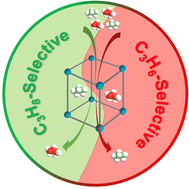Microporous metal–organic frameworks for the purification of propylene
Abstract
Separation of propylene from its analogous hydrocarbons such as propane is of great importance in the petrochemical industry to produce valuable chemical feedstocks with desired purity. However, the well-established method currently used for industrial propane/propylene separation is energy intensive. It involves repeated cycling in the cryogenic and high-pressure distillation process and requires multiple columns and high reflux ratios because of the very similar physical properties of the two species. Thus, it is identified as one of the most capital- and energy-intensive processes. Adsorptive separation based on porous adsorbents is regarded as an alternative energy-efficient technology to replace or supplement the traditional heat-driven cryogenic distillation processes. In this context, metal–organic frameworks (MOFs) have emerged as the most promising candidates for propane/propylene separation, taking into consideration their unique tunability with respect to pore geometry and pore functionality. In this highlight, we summarize the latest advancement in developing MOFs as physisorbents for the separation and purification of propylene from propane, with a focus on those that demonstrate selective molecular exclusion and propane-selective adsorption. We discuss the adsorption preferences related to the material design and separation mechanisms, and review the existing challenges. Finally, we offer our perspectives on various strategies for the future design of MOFs that hold true potential for propylene purification under industrial settings.

- This article is part of the themed collections: 2023 Journal of Materials Chemistry A HOT Papers, Celebrating ten years of Journal of Materials Chemistry A and Celebrating International Women’s Day: Women in Materials Science


 Please wait while we load your content...
Please wait while we load your content...